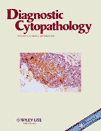Columnar cell lesions: Fine-needle aspiration biopsy features
Abstract
Columnar cell lesions (CCLs) have been described histologically. Frequently, they are noted in biopsies performed for calcifications and are associated with an increased risk of malignancy in the presence of atypia. We sought to characterize the cytological features of CCLs in fine-needle aspirations (FNAs). Twenty FNAs with subsequent histology diagnoses of CCL without carcinoma were reviewed retrospectively. Eighteen of 20 cases were classified as “atypical” on cytology; they had cohesive three-dimensional clusters of enlarged polygonal epithelial cells intermixed with myoepithelial cells in the centers and palisading columnar cells peripherally. Five of these had cytological or architectural atypia on subsequent biopsies, but no significant differences were noted among the 18 aspirates. Calcifications (2/18), snouts (9/18), and bipolar nuclei (11/18) were also identified. The remaining 2/20 FNAs were interpreted as negative because of scant cellularity. In conclusion, CCLs have characteristic cytological traits, and because they may be associated with carcinoma, their recognition is important. Diagn. Cytopathol. 2004;31:370–375. © 2004 Wiley-Liss, Inc.




